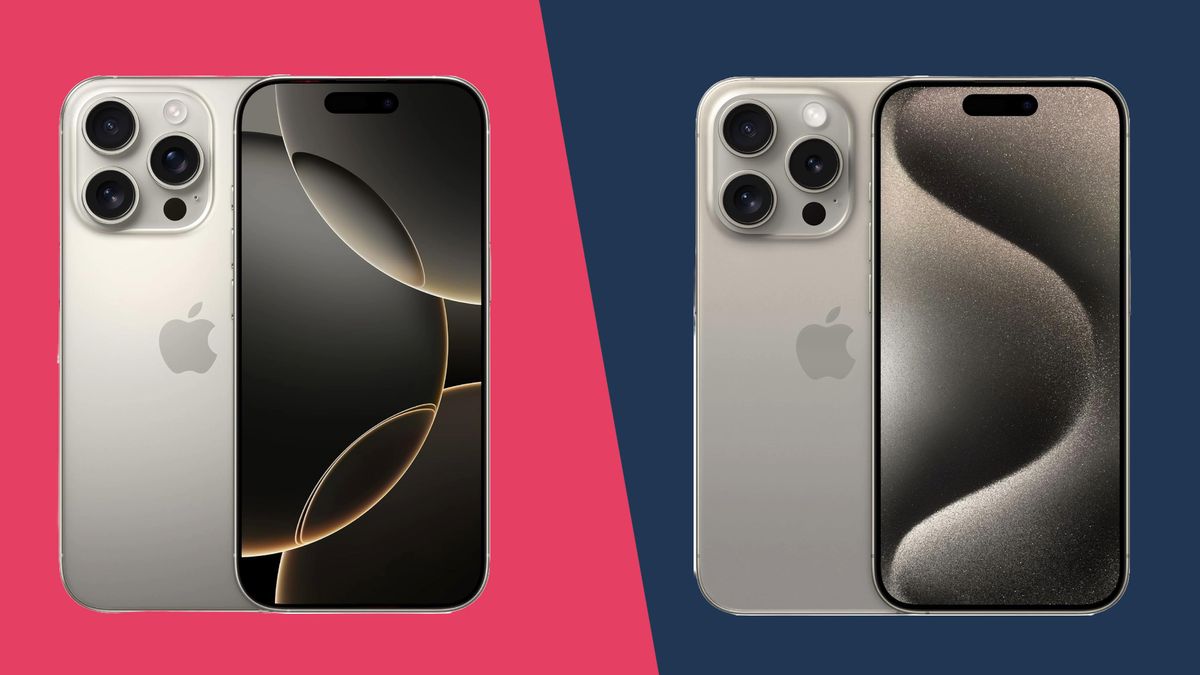This year’s Pro model makes no concessions in return for its compact size, with Apple’s best camera system yet, a slightly larger display, and an all-new Camera Control button.
For
- Appealing compact design
- Camera Control button for instant camera access
- Outstanding A18 Pro performance
Against
- Apple Intelligence is a work in progress
- Storage options should be better
- Screen could be sharper

Apple’s previous compact flagship is even smaller than its successor, but continues to impress with its performance, design, and camera chops.
For
- Compact yet classy titanium design
- USB-C connectivity at last
- Superb performance from A17 Pro
Against
- Battery life is OK rather than great
- Camera spec is not as good as Pro Max
- Not a huge upgrade on the iPhone 14 Pro
Apple has rolled out its latest flagship phone, the iPhone 16 Pro, which means that the iPhone 15 Pro is no longer part of the official iPhone lineup. But is the new model really all that much of an upgrade?
In our iPhone 16 Pro review, we note that Apple’s latest flagship doesn’t represent a sea change versus its predecessor, which begs a couple of questions: If you can pick up an iPhone 15 Pro at a knock-down price from a third-party retailer, is it a smarter buy than the iPhone 16 Pro? And if you already own an iPhone 15 Pro, is it worthwhile upgrading to Apple’s new Pro model?
We’ve now spent a considerable amount of time with both of these phones, so we’ve got a pretty good handle on how they compare. Let’s take a closer look, then, at the iPhone 16 Pro vs iPhone 15 Pro.
iPhone 16 Pro vs iPhone 15 Pro: specs comparison
Before we get to an in-depth breakdown of how these two phones compare, here’s a brief overview of their key specs.
| iPhone 16 Pro | iPhone 15 Pro | |
|---|---|---|
| Dimensions: | 149.6 x 71.5 x 8.3mm | 146.6 x 70.6 x 8.3mm |
| Weight: | 199g | 187g |
| Display: | 6.3-inch 120Hz OLED | 6.1-inch 120Hz OLED |
| Resolution: | 1206 x 2622 | 1179 x 2556 |
| Chipset: | Apple A18 Pro | Apple A17 Pro |
| RAM: | 8GB | 8GB |
| Storage: | 128GB, 256GB, 512GB, 1TB | 128GB, 256GB, 512GB, 1TB |
| Rear cameras: | 48MP wide, 48MP ultra-wide, 12MP 5x telephoto | 48MP wide, 12MP ultra-wide, 12MP 3x telephoto |
| Front camera: | 12MP | 12MP |
| Battery: | 3,582mAh | 3,274mAh |
| Charging: | 20W wired, 25W wireless | 27W wired, 15W wireless |
iPhone 16 Pro vs iPhone 15 Pro: price and availability
The iPhone 16 Pro arrived in shops on September 9, 2024. This was almost a year on from the iPhone 15 Pro, which landed on September 22, 2023.
Launch pricing for the iPhone 16 Pro is in line with its predecessor, with the 128GB model starting at $999 / £999 / AU$1,799. The 256GB model costs $1,099 / £1,099 / AU$1,099, while the 512GB model costs $1,299 / £1,299 / AU$2,349, and the 1TB model costs $1,499 / £1,499 / AU$2,699.
Australian customers are actually getting a slight saving on the iPhone 16 Pro, but in the UK and US, it’s exactly the same price as the iPhone 15 Pro.
Of course, with the iPhone 15 Pro no longer the top dog, and with Apple not even selling it in its own stores, you should be able to secure a healthy discount from third-party retailers. At the time of writing, Amazon UK was selling a 256GB iPhone 15 Pro for £999, which represents a £100 discount.
iPhone 16 Pro vs iPhone 15 Pro: design and display
Apple has broadly held to the same iPhone aesthetic since the launch of the iPhone 12 in 2020. Anyone after something new might be better off waiting for the iPhone 17, if rumors surrounding its design are to be believed.
In the here and now, the iPhone 16 Pro and iPhone 15 Pro look very similar indeed. They have the same basic shape, with the same mostly flat grade 5 titanium rim, and the same Ceramic Shield glass on the front and back.
Their camera modules look exactly the same, with three lenses arranged in a triangular configuration on top of a rounded square platform. Around the front, both phones have the same Dynamic Island notch, which sits away from the bezels and supplies handy heads-up app information.
There are notable design differences that manifest themselves the longer you spend with these two phones, however. The iPhone 16 Pro is actually larger and heavier than the iPhone 15 Pro, for one thing. We’re only talking 3mm taller, about a millimeter wider, and 12g heavier, but the differences are there.
The reason for this is threefold – the newer phone has a slightly larger display and a more capacious battery, as well as a bigger telephoto camera. But it does mean that those who favor smaller phones might want to keep last year’s model in mind.
The other noteworthy design difference is the iPhone 16 Pro’s additional button. The Camera Control sits on the lower right-hand edge of the phone, and serves as both a shortcut to and shutter button for the Camera app. It also acts as a capacitive control for scrolling through various shooting modes.
Both phones get the Action button, which can be mapped to more or less any function you wish. By default, it’s assigned to muting your phone, but the choice is yours.
As we’ve already mentioned, the iPhone 16 Pro’s display is slightly larger than the iPhone 15 Pro’s. There isn’t a lot in it: 6.3 inches for the iPhone 16 Pro, 6.1 inches for the iPhone 15 Pro. This has necessitated a slight increase in pixel count, from 1179 x 2556 in the iPhone 15 Pro to 1206 x 2622 in the iPhone 16 Pro. Both devices produce an almost identical pixel density, however, so there’s nothing of substance to be drawn from those specs.
Indeed, other than size, these two phones essentially have exactly the same display spec. These are both LTPO Super Retina XDR OLEDs with flexible ‘ProMotion’ refresh rates of between 1 and 120Hz. Both can hit a top brightness of 1,000 nits in typical use, and 2,000 nits in high brightness mode (HBM).
Other than a fractional decrease in bezel size on the iPhone 16 Pro, there’s really nothing else to say here. Both of their screens are gorgeous, with outstanding clarity and color accuracy, and you’re unlikely to be disappointed with either.
iPhone 16 Pro vs iPhone 15 Pro: cameras
While the iPhone 15 Pro’s camera set-up didn’t represent a huge upgrade on the iPhone 14 Pro, the iPhone 16 Pro takes a step up in a couple of ways.
Two of the three rear lenses are a notable upgrade. While the 48MP main camera looks very similar indeed to the iPhone 15 Pro’s, the ultra-wide and telephoto cameras are new and improved.
With the ultra-wide, Apple has moved from a 12MP sensor in the iPhone 15 Pro to a 48MP in the iPhone 16 Pro. Meanwhile, the telephoto camera moves up from a 3x optical zoom to a 5x alternative.
This also means that the iPhone 16 Pro’s camera system is a precise match for the iPhone 16 Pro Max’s. One of our criticisms about the iPhone 15 Pro was that its camera system had inferior zoom capabilities to the iPhone 15 Pro Max. The fact that choosing the smaller phone is no longer a compromise is a big win in our book.
One of the most noteworthy improvements with that more pixel-packed ultra-wide camera is the effect it has on macro shots. Those extreme close-ups are now quite a bit sharper.
While the main camera looks very similar on paper, Apple claims that the 16 Pro unit is faster, and we did notice that there was less motion blur with the newer phone when shooting action scenes. The iPhone 16 Pro is also now capable of capturing 4K 120 fps video – aka Cinematic Slow Motion – which makes for some seriously sharp slo-mo shots.
Perhaps the most transformational software addition to the iPhone 16 Pro, at least for photography enthusiasts, is Styles. This essentially lets you pre-process your shots, adjusting how your iPhone handles things like skin tones or shadows.
Other improvements relate to the editing process, with things like the Audio Mix video editing tool that helps you adjust and focus the audio captured in your videos.
Of course, the single biggest difference to the camera relates to the iPhone 16 Pro’s additional Camera Control, which grants an extra level of immediacy and tactile appeal to the photography process.
iPhone 16 Pro vs iPhone 15 Pro: performance and software
Apple has upgraded from the A17 Pro chip in the iPhone 15 Pro to the A18 Pro chip in the iPhone 16 Pro. Shocking, we know.
In practice, the iPhone 15 Pro was already way faster than it had any need to be, flying through games, apps, and tasks with contemptuous ease. The iPhone 16 Pro is technically much faster, and we have the benchmark results to prove it.
But what does it mean to be faster than really fast? Nothing in the here and now, but with the iPhone 16 Pro you’re buying a greater degree of future-proofing. Apple always supports its phones for five years or more, and the iPhone 16 Pro will stay feeling quick for longer.
We say the same thing about iPhones every year, but there’s one potentially interesting fly in the ointment. Apple is due to start rolling AI (that’s Apple Intelligence, don’t you know) features out to iOS 18 over the coming months, and while they’ll be coming to both of these phones, it seems quite possible that the iPhone 16 Pro’s superior hardware will produce a smoother experience. Watch this space.
As we’ve discovered with Android phones running AI tasks, they can place quite a demand on even high-end hardware. The iPhone 16 Pro and the iPhone 15 Pro both have 8GB of RAM, which might place its own shared bottleneck on AI performance. We just won’t know until these features arrive.
Just as with those AI features, almost all of the UI tweaks Apple made to iOS 18 are available to both of these phones. The only real difference will be Visual Intelligence, which is set to be tied to the iPhone 16 Pro’s new Camera Control button. This will let you point your camera at something and have Apple Intelligence tell you more about it.
One other hardware spec advantage that the iPhone 16 Pro has is support for Wi-Fi 7. You won’t be able to take advantage of this with your bog standard broadband package, but there are plenty of Wi-Fi 7 routers on the market, and it’s another thing that makes the iPhone 16 Pro more future-proof than the iPhone 15 Pro.
iPhone 16 Pro vs iPhone 15 Pro: battery
As we noted in the design section, the iPhone 16 Pro is a little bigger and heavier than the iPhone 15 Pro, and one of the contributing factors is its larger battery. While the iPhone 15 Pro has a 3,274mAh cell, the newer phone scales things up to 3,582mAh.
Whether it’s this extra capacity or the more efficient A18 Pro chip – most likely it’s a combination of both – we were able to wring more life out of the iPhone 16 Pro. In our Future Labs battery-drain tests, the new phone lasted 14 hours, which is as much as four hours longer than its older brother.
Don’t get us wrong, both of these phones are ‘charge up every night’ affairs, but the iPhone 16 Pro will let you go harder for longer without failing you.
Apple claims that wired charging remains the same 20W peak across both phones, though there are reports out there that suggest going faster with the iPhone 16 Pro will yield slightly faster results.
One thing that we know for a fact is faster on the iPhone 16 Pro is wireless charging. Apple’s new phone gains support for 25W MagSafe/Qi2 charging, which is an upgrade on the iPhone 15 Pro’s 15W equivalent.
iPhone 16 Pro vs iPhone 15 Pro: verdict
It comes as no surprise to learn that the iPhone 16 Pro is a better phone than the iPhone 15 Pro. It has a slightly larger display, faster performance (for whatever that’s worth), a more flexible camera system, and a brand-new button that makes taking pictures a more tactile experience.
If you’re due an upgrade and are looking at a new top-end iPhone, the newer phone is clearly the best compact option on the market. However, if money is a little tight, or you simply want to get the best value for money, then the day-to-day experience of using these two phones really isn’t very different. With that in mind – not to mention Apple’s exemplary legacy support – the cheaper price of the iPhone 15 Pro makes it a better value pick.
Needless to say, if you already have an iPhone 15 Pro (or arguably even an iPhone 14 Pro), you really don’t need to be upgrading to the iPhone 16 Pro. Next year’s model promises more exciting changes, if rumors are to be believed.
Read the full article here














